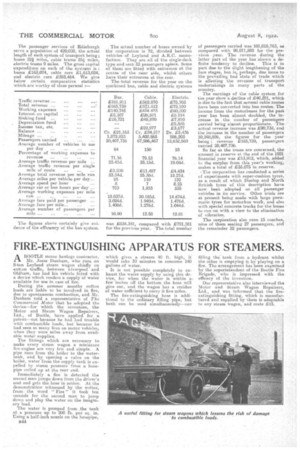A TRIPLE SYSTEM OF PASSENGER TRANSPORT,
Page 27

Page 28

If you've noticed an error in this article please click here to report it so we can fix it.
Edinburgh's Buses Transport Over 20 Million Passengers a Year. Comparative Figures for the Bus, Cable and Electric Systems.
T0 THE BEST of our knowledge e th only city in Great Britain in which &triple system of passenger transport is in vogue is Edinburgh, where the corporation authorities control and operate motorbuses, cable trams and electric trams. Comparative statistics are issued annually in the report of the Tramways Committee, which is responsible for the public passenger services of the city, and this provides instructive data from which it is possible to draw valuable conclusions as to the merits of each form of traction.
The figures contained in the report for the year ended May 15th last will be read and analysed by all those interested in the subject of municipal ownership and operation of passenger vehicles—a subject which has given rise to much heated controversy, particularly amongst those who hold the view that private enterprise can better meet the needs of the travelling public.
The passenger services of Edinburgh serve a population of 420-,000, the actual length of each system of transport being; buses 22i miles, cable trains 251 miles, electric trams 9 miles. The gross capital expenditure on each of the ay-steins is : buses £163,074, cable cars £1,613,024,. and electric cars £393,464. We give below certain comparative statistics which are worthy of close perusal :— The actual number of buses owned by the corporation is .72, divided between vehicles. of Leyland and A.E.C. manufacture. They are all of the single-deck type and seat 32 passengers apiece. Some of them are fitted with entrances at the centre of the near side, whilst others have their entrances at the rear.
The total revenue for the year on the combined bus, cable and electric systems of passengers carried was 101,026,763, as oompared with 98,011,882 for the previous year. The revenue during the latter part of the year has shown a de finite tendency to decline. This is its part due to the Slight lengthening of the fare stages, but is, perhaps, due more to the prevailing bad state of trade which is affecting the revenue of transport undertakings in many parts of the country. The earnings of the cable system for the year show a decline of £40,291, which is due to the fact that several cable routes have been converted into bus routes. The income from the motorbuses for the past year has been almost doubled, the increase in the number of pa.ssehgers carried being aimost proportionate. The actual revenue increase was £90,739, and the increase in the number of passengers 10,248,926, the figures for the year being : revenue £183,739, passengers carried 20,407,736. Su far as the buses are concerned, the amount in reserve at the end of the 1921 financial year was £13,912, whiCh, added to the surplus from this year's working, makes a total of £35,075 in reserve.
The corporation has conducted a series of experiments with super-cushion tyres, as a result of which Dunlap and North British tyres of this description have now. been adopted on all passenger vehicles iv its service. Other trials are at present being made with large pneumatic tyres for motorbus work, and also with special concrete tracks for the buses to run on with a view to the elimination of vibration.
The corporation also runs 15 coaches, nine of them seating 27 passengers, and the remainder 32 passengers.
































